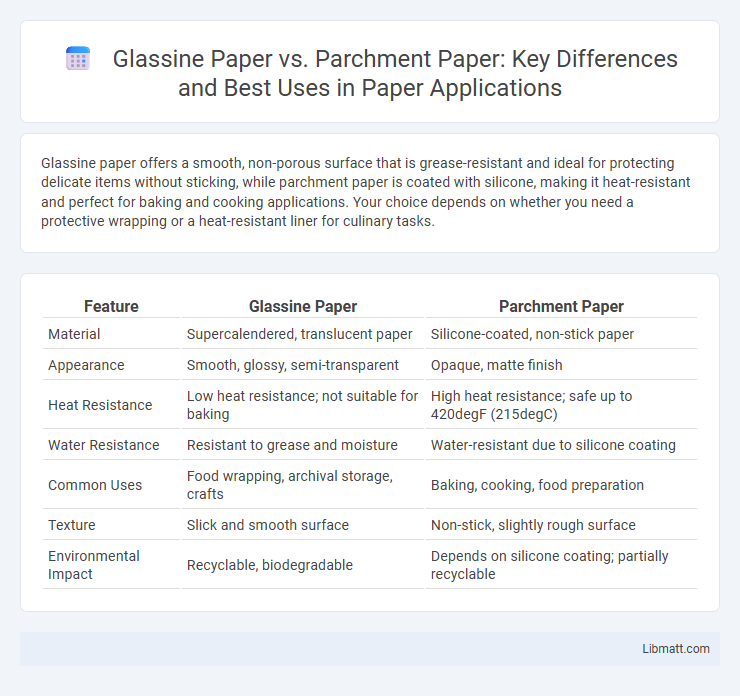Glassine paper offers a smooth, non-porous surface that is grease-resistant and ideal for protecting delicate items without sticking, while parchment paper is coated with silicone, making it heat-resistant and perfect for baking and cooking applications. Your choice depends on whether you need a protective wrapping or a heat-resistant liner for culinary tasks.
Table of Comparison
| Feature | Glassine Paper | Parchment Paper |
|---|---|---|
| Material | Supercalendered, translucent paper | Silicone-coated, non-stick paper |
| Appearance | Smooth, glossy, semi-transparent | Opaque, matte finish |
| Heat Resistance | Low heat resistance; not suitable for baking | High heat resistance; safe up to 420degF (215degC) |
| Water Resistance | Resistant to grease and moisture | Water-resistant due to silicone coating |
| Common Uses | Food wrapping, archival storage, crafts | Baking, cooking, food preparation |
| Texture | Slick and smooth surface | Non-stick, slightly rough surface |
| Environmental Impact | Recyclable, biodegradable | Depends on silicone coating; partially recyclable |
Introduction to Glassine Paper and Parchment Paper
Glassine paper is a smooth, glossy, and translucent paper often used for packaging, food wrapping, and art projects due to its grease-resistant and moisture-resistant properties. Parchment paper, on the other hand, is a non-stick, heat-resistant paper commonly used in baking and cooking to prevent food from sticking and to withstand high oven temperatures. Understanding the unique characteristics of glassine and parchment paper helps you choose the right material for your specific culinary or craft needs.
What is Glassine Paper?
Glassine paper is a smooth, glossy, and translucent paper that is air, water, and grease resistant, making it ideal for packaging and protecting delicate items such as photographs and food. Unlike parchment paper, which is coated with silicone to provide non-stick and heat-resistant properties, glassine paper is created by densely compressing cellulose fibers, resulting in a strong and transparent material. You can use glassine paper for archival storage, wrapping, and baking applications where moisture resistance but minimal sticking is required.
What is Parchment Paper?
Parchment paper is a heat-resistant, non-stick paper commonly used in baking and cooking to prevent food from sticking and to facilitate easy cleanup. It is coated with silicone, making it moisture and grease resistant while maintaining durability at high temperatures up to 425degF (220degC). Unlike glassine paper, which is smooth and translucent but not heat-resistant, parchment paper is specifically designed for oven use and food preparation.
Key Differences Between Glassine and Parchment Paper
Glassine paper is smooth, glossy, and non-porous, providing excellent grease resistance and moisture protection, while parchment paper is coated with silicone, making it heat-resistant and non-stick for baking purposes. Glassine is commonly used for packaging and archival storage due to its transparency and durability, whereas parchment paper is ideal for cooking, preventing food from sticking and enabling easy cleanup. Your choice depends on whether you need a moisture barrier and clarity (glassine) or a heat-tolerant, non-stick surface (parchment).
Common Uses for Glassine Paper
Glassine paper is commonly used for food packaging, including bakery goods and candy, due to its grease-resistant and moisture-resistant properties. It serves as a protective interleaving material in art storage and archival applications, preventing smudging and damage to delicate documents or photos. Your choice of glassine paper ensures a smooth, non-stick surface ideal for preserving freshness and protecting items from contamination.
Common Uses for Parchment Paper
Parchment paper is widely used in baking to provide a non-stick surface for cookies, cakes, and pastries, helping prevent sticking and ensuring even cooking. It is also commonly used to line cake pans and baking sheets, facilitating easy cleanup and protecting bakeware. Additionally, parchment paper can be used for cooking en papillote, where food is steamed in a parchment pouch, locking in moisture and flavor.
Heat Resistance and Baking Suitability
Glassine paper offers moderate heat resistance, making it suitable for wrapping and storing food but not ideal for direct baking due to its lower tolerance for high temperatures. Parchment paper is highly heat resistant, typically withstanding temperatures up to 450degF (232degC), which makes it perfect for lining baking sheets and pans, preventing sticking and promoting even cooking. If your baking requires exposure to high heat, parchment paper is the better choice to ensure safety and optimal results.
Food Safety and Non-stick Properties
Glassine paper offers excellent food safety by being non-toxic, grease-resistant, and moisture-resistant, making it ideal for wrapping dry foods or baked goods without risk of contamination. Parchment paper provides superior non-stick properties due to its silicone coating, allowing for easy release of baked items while also maintaining food-safe standards suitable for direct contact with various foods. Both papers are widely used in culinary applications to preserve food quality, but parchment paper is preferred when strong non-stick performance is essential.
Sustainability and Environmental Impact
Glassine paper is highly recyclable and biodegradable, often made from cellulose fibers sourced from sustainably managed forests, making it an eco-friendly choice for packaging and food storage. Parchment paper, while also biodegradable, is typically coated with silicone or other non-stick agents that can hinder compostability and complicate recycling processes. Choosing glassine paper supports a lower environmental footprint through enhanced recyclability and reduced chemical treatments compared to parchment paper.
Choosing the Right Paper for Your Needs
Glassine paper offers a smooth, glossy, and non-porous surface ideal for protecting delicate items and providing moisture resistance, while parchment paper features a non-stick, heat-resistant coating perfect for baking and cooking tasks. Your choice depends on whether you need moisture and grease protection without heat exposure (glassine) or a reliable, non-stick surface for oven use (parchment). Both papers serve distinct purposes, so understanding their properties ensures you select the right one for your specific project or culinary need.
glassine paper vs parchment paper Infographic

 libmatt.com
libmatt.com